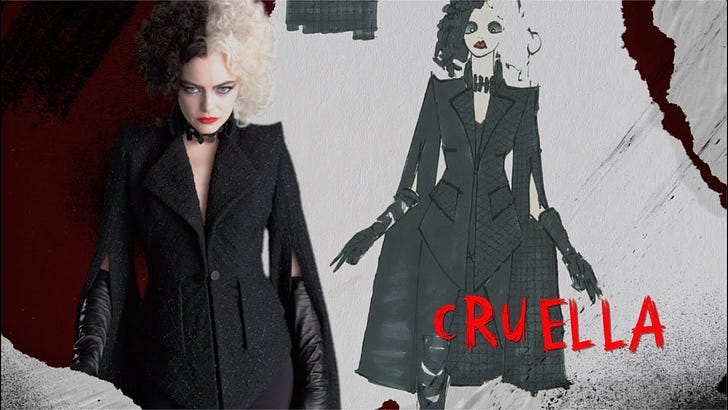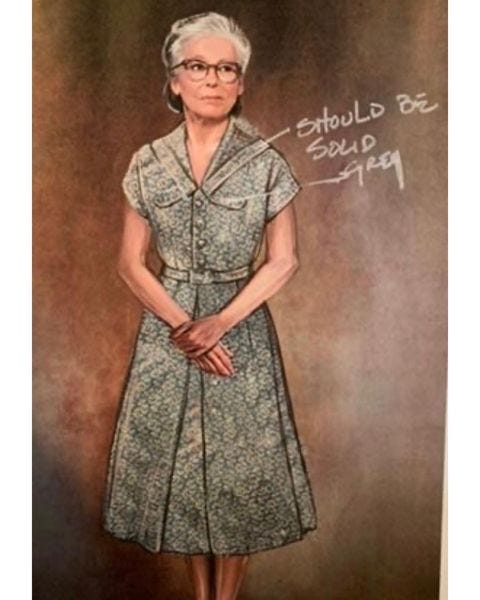Numlock Awards is your one-stop awards season newsletter. Every week, join Walt Hickey and Michael Domanico as they break down the math behind the Oscars and the best narratives going into film’s biggest night. Today’s edition comes from Michael.
While Walter is updating his charts on the main races, I wanted to start diving into some of the below-the-line categories. Let’s start with one of my favorites, Best Costume Design.
The category is often dominated by repeat players, and we have quite a few this time around as well:
Cruella, costumes by Jenny Beavan (11 nominations, 2 wins)
Dune, costumes by Jacqueline West (4 nominations) and Robert Morgan (first nomination)
Nightmare Alley, costumes by Luis Sequeira (2 nominations)
West Side Story, costumes by Paul Tazewell (first nomination)
Cyrano, costumes by Massimo Cantini Parrini (2 nominations) and Jacqueline Durran (8 nominations, 2 wins)
They’re all nominated at the Costume Designers Guild Awards, four in the same category (period film) and Dune in the sci-fi/fantasy category.
Cruella, Jenny Beavan
You may remember Jenny Beavan as the designer of Mad Max: Fury Road. She won the Oscar for that movie and showed up to the ceremony in a biker jacket, and an infamous Vine was made showing Alejandro González Iñárritu not applauding and looking generally unimpressed. (He later clarified he did indeed clap and learned to “never cross my arms when I am sitting down.”)
Cruella’s main advantage going into Oscar night is that the film is explicitly about fashion. While the movie has some bizarro plot involving murderous dalmatians and multiple cliffside homicides, the fashion is front and center throughout, as Emma Stone’s Estella/Cruella faces off against Emma Thompson’s Baroness as they both try to one up the other’s fashion and gain the attention of the notoriously friendly and welcoming British press.
The movie is also set in the 1970s (though I’m not sure why since it’s a prequel to a movie that came out in 1961, but sure) so you get a lot of punk rock and underground-influenced looks, as opposed to Beavan’s standard repertoire of Merchant & Ivory turn-of-the-century period pieces.
If you haven’t seen the film, you can see in the video below one of Cruella’s more memorable looks, the dumpster dress — a massive dress compiled from a bunch of old dresses, with a nice finishing touch of some newspaper for that trashy feel, as Estella/Cruella rides off on a garbage truck (again, bizarre plot that’s nearly impossible to follow). This was done without CGI, a rarity today when adding in digital effects can be so easy:
“It needed to have a look of spring colors, and a lot of those are real dresses in there, but they’re obviously not particularly good ones. They’re ones we could find in relatively cheap shops. Totally physical, totally Emma Stone on the back of the dumpster truck, done at two in the morning at the bottom of Regent Street Every time I pass it, I remember how we were all set up down there and it was freezing cold, as it is in London by November or whenever we shot it. It was absolutely done for real.” — Deadline.
Dune, Jacqueline West and Robert Morgan
Dune is probably Cruella’s biggest competition. Designers Jacqueline West and Robert Morgan have estimated they made 2,000 costumes, including 250 bespoke stillsuits.
What is a stillsuit, you ask? Walter can give a better rundown of Dune lore than I can, but the simplest explanation is: it’s a thing that looks cool and keeps you cool when you end up on a desert planet with giant sandworms. It’s the costume you saw in most Dune promos, that form-fitting black suit with the nose piece.
The suits weren’t fully functional, but they were designed to keep the actors somewhat cool while shooting in Jordan:
“It’s not unlike some of [the] fabric that Under Armour uses to wick water away from the body when football players wear it under their football padding. We selected a beautiful Japanese fabric that would wick water from the body and then it would kind of cool the body when the moisture hit the air of Jordan, through a mesh system of cotton, nylon and acrylic. When there was a breeze in the desert, there was a cooling effect on the wearer — and the actors said it really worked.” – Hollywood Reporter.
West and Morgan also had to create battle armor, a muumuu for Baron Harkonnen, and a variety of other futuristic-meets-medieval (or “modieval,” as West calls it) looks.
To pull it all off, West got Morgan elevated to costume designer — in fact, this is his first film credit as a costume designer. He previously worked as a costume supervisor, which is essentially the person running the day-to-day, keeping the hundreds (or thousands) of costumes organized, and making sure everything in the costume department is running smoothly. Credits of his as costume supervisor include Indiana Jones and the Kingdom of the Crystal Skull, Inception, and X-Men: Days of Future Past. So it’s not shocking given his work on blockbusters that West — who mainly does smaller projects like The Tree of Life and The Social Network — brought him on board.
Nightmare Alley, Luis Sequeira
This is Luis Sequeira’s second film with director Guillermo del Toro — he previously received an Oscar nomination for 2017’s The Shape of Water.
Sequeira started working on Nightmare Alley in June 2019, and filming started in January 2020. Because of some scheduling things, they had filmed the second half of the movie first. Then, the pandemic hit, they shut down for six months, and resumed in the fall to shoot the first half of the movie, which largely takes place at the carnival.
Sequeira described how some of those logistics difficulties affected his work:
“[We] waited six months to start back up. And then we proceeded to do the carnival and had six weeks to prepare for the carnival, which seems like a long time but all of the prep work we had done prior, a lot of it was null and void. Those extras were no longer available, and so we had to refit those folks. We finished around Christmas, so it was a very long process and I was thankful for the time, because even in the downtime it gave me an opportunity to really move away from the city and really focus on the country aspect of the film.” — SlashFilm.
He also wanted to blend different eras — the movie takes place from 1939 to 1941, and Sequeira wanted to show the difference between the haves, who could afford what was fashionable and new in ’41, and the have-nots, who would have clothes in their drawers from the ’30s and even the ’20s. According to Sequeira, 90% of what the main characters wore was created by him and his team.


West Side Story, Paul Tazewell
This is a very Hamilton Oscars — Lin-Manuel Miranda is nominated for a song from Encanto, Ariana DeBose is nominated for Best Supporting Actress for West Side Story, and Paul Tazewell, who won a Tony for designing Hamilton’s costumes, is nominated for doing the same for West Side Story. (It’s also worth noting that 1961’s West Side Story won this award in the color category.)
You can see some of Tazewell’s design process on his Instagram, refining what Rita Moreno would wear. He mentions a bit about the conversations they had about whether she should wear pants or a dress.
Ultimately, they went with Moreno’s suggestion that her first outfit should be pants since she didn’t want to just be the old lady, and the pants would make her look more active.
For the Sharks and the Jets, he leaned on the work of photographer Bruce Davidson to capture the look of gangs from the era. To differentiate between the Jets and the Sharks, he put the Jets in cooler shades and denims and the Sharks in slicker outfits with warmer shades and more patterns.
“Many of the Jets were from broken homes and struggling and seeing their neighborhood destroyed. Then, the Latinx immigrant communities were coming to New York with the hopes of bettering themselves—they’re more aspirational. The Jets are essentially street gangs hanging out all over New York, and the Sharks are a contrast to that. I was hoping that the clothing would set that up, even in how they dress up for an event, like the dance in the gym” — Vogue.
Cyrano, Massimo Cantini Parrini and Jacqueline Durran
Maybe I’m unfairly counting out Cyrano here — the 1990 adaptation won the Oscar in this category. But I’m having a hard time getting too excited about Cyrano, a movie that has barely even come out.
Parrini is an interesting figure. Last year, he was nominated for that bonkers version of Pinocchio, and I wrote a bit about him and his massive archive of clothing spanning three centuries. I also noted he had won the Italian version of the Oscar (the David di Donatello Awards) four times, and he has since bumped that up to five. I’m expecting him to become a regular at the Oscars, much like his collaborator Jacqueline Durran, who has two Oscars already (for 2012’s Anne Karenina and 2019’s Little Women).
I doubt this is the movie that gets Durran her third Oscar, given that it barely has registered with any awards body and hasn’t even had a chance to register with audiences yet.
If there’s another category you’re super interested in, feel free to email us and I’ll see what I can pull together.


